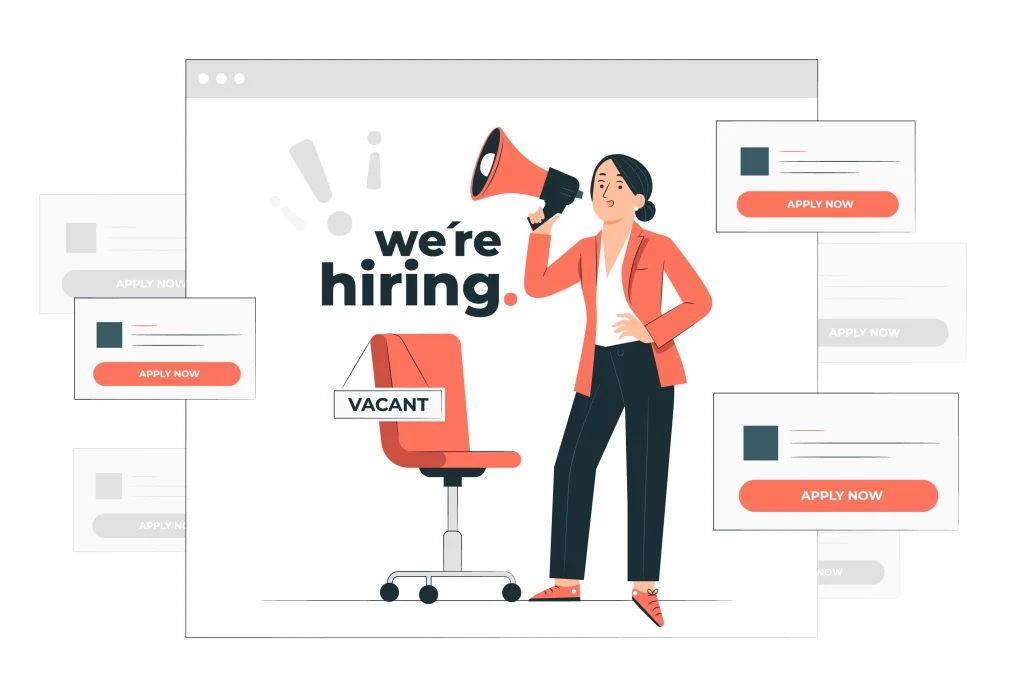
In the intricate dance of corporate success, effective recruitment is a linchpin determining businesses’ fate. The stakes are high, and the consequences of bad recruiting decisions can send shockwaves that reverberate far beyond the HR department. From the initial investment in attracting talent to the long-term implications on team dynamics, innovation, and legal ramifications, the financial fallout of poor recruiting practices is an often underestimated peril that can lead to a business’s financial downfall.
As organizations navigate the competitive landscape, the understanding that recruitment is not merely a task to fill vacancies but a strategic investment in the company’s future becomes paramount. A misstep in hiring can set off a chain reaction, unraveling the delicate fabric that holds together a thriving enterprise. In this exploration, we delve into the myriad ways in which bad recruiting decisions manifest as a silent financial adversary, capable of jeopardizing a business’s stability, growth, and ultimately, its financial standing in the market.
Financial Implications
One of the most direct and immediate consequences of bad recruiting is its financial toll on a business. The recruitment process involves various expenses, from advertising job openings to conducting interviews and background checks. When a hiring decision turns out to be a poor fit, the investment made in the recruitment process goes down the drain. Additionally, the cost of rehiring and retraining for the same position further escalates the financial burden.
The High Cost of Bad Recruiting:
- Initial Investment Gone Awry:
The recruitment process involves a series of financial investments – from job postings and screening processes to interviews and background checks. When a hiring decision proves to be a mismatch, the initial investment made in attracting, assessing, and selecting the candidate essentially goes to waste. This direct financial loss is the tip of the iceberg in the aftermath of a bad hire. - Costs of Rehiring and Retraining:
Beyond the sunk costs of the unsuccessful recruitment process, companies must face the additional financial strain of rehiring and retraining for the same position. These costs include advertising the position again, conducting further interviews, and providing training to bring the new hire up to speed. It’s a double hit to the budget that could have been avoided with a more strategic initial hiring decision.
The financial implications of poor recruiting practices are twofold. Not only does the company lose the resources invested in the initial recruitment process, but it also incurs additional costs in rectifying the hiring mistake. By recognizing the true cost of bad recruiting decisions, businesses can emphasize the importance of thorough and strategic hiring processes, ensuring a more prudent allocation of resources and safeguarding against unnecessary financial setbacks. A robust recruitment strategy is not just an investment in talent; it is a strategic financial decision that can profoundly impact the bottom line.

Decreased Productivity
A bad hire can significantly impact overall team productivity. When an employee lacks the necessary skills or struggles to integrate into the team, it can lead to delays, errors, and a decline in overall efficiency. The ripple effect of decreased productivity can be felt across different departments, affecting the company’s ability to meet deadlines and deliver on client expectations.
The Toll of Decreased Productivity:
- Skill Mismatch and Task Delays:
When a candidate’s skills do not align with the demands of the role, it inevitably leads to task delays and inefficiencies. The new hire may struggle to perform tasks at the expected pace, creating bottlenecks and disrupting the workflow of the entire team. - Error Amplification:
An inadequately recruited employee is prone to making mistakes due to a lack of understanding or proficiency in their assigned responsibilities. These errors, if left unaddressed, can escalate and impact the quality of products or services, tarnishing the company’s reputation and client satisfaction. - Training Time as a Bottleneck:
In cases where a new hire requires extensive training, it becomes a bottleneck in the production process. Time spent training takes away from the actual execution of tasks, elongating project timelines and hindering the achievement of business objectives.
The ripple effect of poor recruiting decisions goes beyond the confines of the recruitment process itself and directly influences the productivity landscape within a company. A misfit in skills and competencies can lead to task delays, increased errors, and training-related bottlenecks, all of which substantially decrease overall productivity. Recognizing the intimate connection between recruitment and productivity is vital for businesses aiming to build high-performing teams and maintain a competitive edge in today’s fast-paced business environment. A strategic and meticulous recruitment approach invests talent and is a cornerstone in sustaining and enhancing organizational productivity.

Negative Impact on Company Culture
A single bad hire can disrupt the harmony of a well-established company culture. A new employee failing to align with the organization’s values and work ethic can create tension among existing team members. This can lead to increased turnover as employees become dissatisfied with the work environment, further perpetuating the cycle of bad hires and negatively impacting the company’s reputation.
The Unraveling of Company Culture:
- Cultural Misalignment:
A bad hire can disrupt the delicate balance of a well-established company culture. If a new employee fails to align with the organization’s values, work ethic, or communication style, it can create tension and friction among existing team members. This misalignment can lead to a breakdown in trust and collaboration, eroding the core elements that define a positive workplace culture. - Impact on Morale and Engagement:
Company culture is intricately tied to employee morale and engagement. When a new hire does not integrate well or actively works against the cultural norms, it can negatively impact the morale of the entire team. Existing employees may feel disheartened, questioning the company’s commitment to maintaining a positive and supportive work environment. - Increased Turnover and Dissatisfaction:
The negative effects of a misfit in company culture often manifest in increased turnover. Employees who are dissatisfied with the changing dynamics may seek opportunities elsewhere, leading to a loss of valuable talent and institutional knowledge. This turnover further perpetuates a cycle of disruption, hindering the company’s stability and growth.
The ramifications of poor recruitment decisions extend beyond immediate skill gaps to the very fabric of a company – its culture. Cultural misalignment can sow discontent, impacting employee morale and engagement and ultimately increasing turnover. Recognizing the symbiotic relationship between recruitment and company culture is imperative for businesses striving to foster a positive and cohesive work environment. A meticulous recruitment strategy, rooted in an understanding of cultural dynamics, not only brings in skilled individuals but also ensures the preservation and enhancement of the organization’s unique cultural identity. In this way, a strategic recruitment approach becomes a cornerstone for long-term organizational success.

Legal Consequences
Making a poor hiring decision can sometimes result in legal complications. If an employee is not properly vetted or the hiring process lacks transparency, it can lead to legal issues such as wrongful termination claims or allegations of discrimination. Legal battles are not only time-consuming but can also incur significant financial costs in terms of legal fees and settlements.
Navigating Legal Consequences:
- Wrongful Termination Claims:
Poorly executed recruitment processes can result in situations where an employee claims wrongful termination. If the hiring decision was based on discriminatory practices, a lack of proper vetting, or misrepresented job expectations, the company may find itself facing legal battles and potential financial repercussions. - Discrimination Allegations:
Discrimination in the hiring process, whether intentional or inadvertent, can lead to serious legal consequences. Candidates who feel they were unfairly treated due to factors like age, gender, race, or disability may file discrimination claims against the company. Such allegations can result in lengthy legal battles, tarnishing the company’s reputation and financial stability. - Inadequate Background Checks:
Neglecting thorough background checks can expose a company to legal risks. If an employee with a history of misconduct or criminal activity causes harm within the workplace, the company may be held liable for negligent hiring practices. Legal actions resulting from such incidents can have severe financial and reputational repercussions.
The legal consequences of poor recruiting practices are not to be underestimated. Wrongful termination claims, discrimination allegations, and inadequate background checks can lead to legal battles that drain financial resources and damage a company’s reputation. Understanding and prioritizing legal compliance in the recruitment process is essential for businesses to navigate the complex landscape of employment law successfully. A strategic recruitment approach, coupled with a commitment to transparency and fairness, mitigates legal risks and reinforces a company’s commitment to ethical and lawful business practices. In this way, a well-executed recruitment strategy becomes a shield against potential legal pitfalls, safeguarding the company’s future.

Time Wasted on Micromanagement
When a business hires someone who does not meet the expected standards, managers may spend excessive time micromanaging the new employee. This diversion of time and energy away from strategic planning and important business tasks can hinder the company’s overall growth and development.
Navigating Micromanagement Mayhem:
- Inadequate Skill Matching:
When a new hire lacks the necessary skills or struggles to meet performance expectations, managers may feel compelled to step in and closely monitor the employee’s tasks. This micromanagement is often a result of the initial misalignment between the candidate’s capabilities and the demands of the role, leading to a drain on managerial time. - Communication Breakdowns:
Poor communication skills or a lack of understanding of job responsibilities can lead to constant supervision by managers. The need for detailed guidance and clarification on tasks that should be routine can create a cycle of micromanagement, hindering the manager’s ability to focus on broader strategic initiatives. - Time-Consuming Corrections:
Managers are forced into a reactive mode when dealing with a new hire’s errors or subpar performance. Correcting mistakes and providing additional guidance require significant time and attention, preventing managers from focusing on proactive measures to enhance the team’s overall productivity.
The hidden cost of poor recruiting practices manifests as micromanagement mayhem. A mismatch between a new hire’s skills and job requirements can lead to communication breakdowns, time-consuming corrections, and a drain on managerial resources. Recognizing the impact of inadequate recruitment on managerial efficiency is crucial for businesses aiming to cultivate high-performing teams and efficient leadership structures. A strategic recruitment approach prioritizes skill alignment and cultural fit prevents micromanagement challenges and empowers managers to focus on strategic initiatives, fostering a workplace environment that thrives on autonomy and efficiency. In this way, a well-executed recruitment strategy catalyzes effective leadership and overall organizational success.

Impact on Employee Morale
A bad hire can negatively impact the morale of the entire team. Existing employees may become disheartened by the additional workload or frustrated with the need to correct mistakes made by the new hire. This demoralization can increase turnover among high-performing employees seeking a more positive and supportive work environment.
Unpacking the Impact on Morale:
- Dissatisfaction with Work Environment:
A new hire who fails to integrate well with the team or align with the company’s values can create dissatisfaction among existing employees. Witnessing a shift in the workplace dynamics can lead to a sense of discomfort and discontent, eroding the positive atmosphere that contributes to high morale. - Increased Workload and Frustration:
If a new hire is unable to fulfill their responsibilities effectively, it often falls on the shoulders of existing team members to pick up the slack. The resultant increase in workload and frustration can significantly impact morale, leading to burnout and a sense of disillusionment among the workforce. - Perceived Lack of Company Investment:
Employees are likely to interpret poor recruiting decisions as a lack of investment by the company in building a high-performing and cohesive team. This perception can lead to a decrease in morale as employees may feel undervalued and question the commitment of the organization to fostering a positive work environment.
The impact of poor recruiting practices on employee morale is a critical consideration for businesses aiming to maintain a positive and productive workplace culture. A misfit in skills, values, or work ethic can lead to dissatisfaction, frustration, and a perceived lack of company investment, all contributing to a decline in overall morale. Recognizing the intricate connection between recruitment and employee morale is vital for businesses committed to cultivating a workplace where employees feel engaged, valued, and motivated. A strategic recruitment approach prioritizes cultural fit and aligns with the organization’s values avoids moral pitfalls and contributes to a positive and harmonious work environment. In this way, a well-executed recruitment strategy becomes a cornerstone for sustained employee satisfaction and organizational success.

Training Costs
When a new employee is not a good fit for the role, the company may need additional training to address skill gaps or performance issues. These training costs can accumulate quickly and, in the end, may not yield the desired results if the employee is fundamentally unsuitable for the position.
Navigating the Escalation of Training Costs:
- Skill Gaps and Additional Training Needs:
Recruiters who lack the necessary skills for their role often require additional training to bridge the gap. Whether it’s technical skills or understanding the company’s specific processes, the need for supplementary training financially strains the organization. - Time and Resource Intensiveness:
The time and resources invested in training a new employee can be substantial. When a poor hiring decision necessitates extensive training, it diverts attention and resources away from other critical aspects of business development. This intensiveness contributes to a tangible increase in overall training costs. - Potential Diminishing Returns:
Despite the investment in training, there’s no guarantee of a positive return if the employee is fundamentally unsuitable for the position. This potential for diminishing returns compounds the financial impact, as the organization not only incurs training costs but may also face the prospect of having to repeat the process if the employee proves unable to meet expectations.
The escalation of training costs is an often-overlooked consequence of poor recruiting practices. Skill gaps and the need for extensive training can strain organizational resources in terms of time and financial investment. Recognizing the importance of aligning recruitment decisions with the actual requirements of the role is essential for businesses seeking to mitigate the impact on training costs. A strategic recruitment approach that emphasizes thorough evaluation and cultural fit minimizes the need for excessive training and ensures a more prudent allocation of resources. In this way, a well-executed recruitment strategy becomes a pivotal factor in optimizing training investments and fostering long-term organizational success.

Missed Opportunities for Innovation
A poor hiring decision affects day-to-day operations and can hinder a company’s ability to innovate and adapt to changing market conditions. A team of skilled and motivated individuals is more likely to generate creative solutions and contribute to developing new ideas, positioning the business for long-term success.
Exploring the Consequences of Innovation:
- Lack of Diverse Perspectives:
A workforce that lacks diversity, whether in skills, experiences, or perspectives, is likely to struggle with generating innovative ideas. Poor recruiting practices that do not prioritize diversity can lead to a homogenous team, limiting the range of perspectives that contribute to creative problem-solving and innovation. - Resistance to Change:
Employees who are a poor fit for their roles may resist change, hindering the company’s ability to adapt to market trends and technological advancements. Innovations often require a team open to new ideas and approaches, and a lack of alignment in the workforce can result in missed opportunities for innovation. - Diminished Creative Solutions:
When employees are not adequately skilled or motivated due to poor hiring decisions, the team’s creative potential is compromised. A workforce that lacks the capacity to think critically and generate creative solutions is more likely to miss out on opportunities to innovate and stay ahead in a competitive market.
The silent cost of poor recruiting decisions manifests in missed opportunities for innovation. A workforce that lacks diversity resists change, and cannot contribute creatively hampers a company’s ability to innovate and adapt to the ever-changing business landscape. Recognizing the profound impact of recruitment on innovation is crucial for businesses aspiring to stay at the forefront of their industries. A strategic recruitment approach prioritizes diversity, adaptability, and creative thinking minimizes the risk of missed innovation opportunities and positions the company for sustained success. In this way, a well-executed recruitment strategy catalyzes a culture of innovation and ensures the organization remains agile and competitive in a rapidly evolving business environment.

Team Dynamics and Collaboration
A mismatched hire can disrupt the synergy within a team. Effective collaboration relies on individuals working cohesively towards common goals. When a new team member does not integrate well or lacks the necessary interpersonal skills, it can lead to communication breakdowns, conflicts, and an overall decrease in team cohesion.
Exploring the Consequences of Team Dynamics:
- Communication Breakdowns:
A team member who does not integrate well with the rest of the group can lead to communication breakdowns. Misunderstandings, lack of clarity, and a breakdown in effective communication hinder the seamless flow of ideas and information within the team. - Conflict and Tension:
Poorly aligned team members can result in internal conflicts and tension. When values, work styles, or goals diverge, it creates an atmosphere of discord that can impede collaboration. This conflict not only affects the individuals involved but can have a ripple effect, disrupting the collaborative spirit of the entire team. - Reduced Trust and Cohesion:
Trust is a cornerstone of effective teamwork. A misfit within the team erodes the trust that is crucial for collaboration. Reduced trust can lead to a lack of cohesion, hindering the team’s ability to work together seamlessly towards common goals.
The impact of poor recruiting decisions extends beyond individual performance to the broader dynamics of team collaboration. Communication breakdowns, conflicts, and diminished trust can profoundly affect a team’s effectiveness. Recognizing the importance of strategic recruitment in fostering positive team dynamics is essential for businesses aiming to cultivate high-performing and cohesive teams. A meticulous recruitment approach prioritizes not only individual skills but also cultural fit and teamwork, ensuring that the harmony within the team remains intact. In this way, a well-executed recruitment strategy becomes a cornerstone for sustained collaboration, enabling the team to navigate challenges and achieve collective success.

Innovation and Adaptability
Adaptability and innovation are crucial for staying competitive in a rapidly changing business landscape. Bad recruiting may result in a workforce resistant to change or lacking the creativity to navigate evolving market trends. A team of uninspired individuals may struggle to adapt, hindering the company’s ability to seize new opportunities.
Exploring the Consequences of Innovation and Adaptability:
- Creativity Crunch:
A workforce that lacks diversity and individuals with varied perspectives often experiences a creativity crunch. Poor recruiting practices overlooking the importance of diverse backgrounds and innovative thinking can result in a team struggling to generate new ideas and solutions. - Resistance to Change:
Employees who are a poor fit for their roles may resist change, hindering the company’s ability to adapt to new technologies, market trends, or evolving customer needs. Innovation requires a team open to new ideas and approaches, and a lack of alignment in the workforce can lead to resistance rather than adaptation. - Inability to Pivot:
An adaptable workforce is essential when faced with unexpected challenges or shifts in the market. Poor hiring decisions that result in a team with limited adaptability hinder the organization’s capacity to pivot and seize new opportunities, potentially leading to stagnation or decline.
The consequences of poor recruiting decisions on innovation and adaptability are profound. A lack of creativity, resistance to change, and an inability to pivot can significantly impact a company’s ability to thrive in a dynamic business environment. Recognizing the pivotal role of recruitment in fostering a culture of innovation and adaptability is crucial for businesses aiming to stay ahead of the curve. A strategic recruitment approach that values diverse perspectives, innovative thinking, and adaptability ensures that the workforce remains resilient and capable of navigating the challenges of an ever-changing marketplace. In this way, a well-executed recruitment strategy catalyzes continuous progress and long-term organizational success.

Impact on Employee Engagement
Employees thrive when they feel engaged, challenged, and valued. A poor hiring decision can create dissatisfaction among existing team members, who may feel that the company is not invested in building a high-performing and motivated workforce. Low employee engagement can lead to increased absenteeism, decreased productivity, and a higher likelihood of turnover.
Exploring the Consequences of Employee Engagement:
- Dissatisfaction and Disconnection:
A new hire who fails to integrate well with the team or align with the company’s values can create dissatisfaction among existing employees. Witnessing a cultural misfit can lead to a sense of disconnection, impacting the camaraderie and shared sense of purpose that fosters high levels of engagement. - Increased Workload and Burnout:
When a new hire cannot fulfill their responsibilities effectively, it often falls on existing team members to pick up the slack. The resultant increase in workload can lead to burnout, diminishing the enthusiasm and energy levels that contribute to sustained employee engagement. - Perceived Lack of Investment:
Employees may interpret poor recruiting decisions as a lack of investment by the company in building a high-performing and cohesive team. This perception can decrease engagement, as employees may feel undervalued and question the organization’s commitment to fostering a positive work environment.
The impact of poor recruiting practices on employee engagement is a critical consideration for businesses seeking a thriving and motivated workforce. Dissatisfaction, increased workload, and a perceived lack of investment can erode the crucial engagement levels for sustained productivity and retention. Recognizing the intricate connection between recruitment and employee engagement is vital for businesses committed to cultivating a workplace where employees feel connected, valued, and motivated. A strategic recruitment approach that prioritizes cultural fit aligns with organizational values and promotes a positive work environment, avoiding engagement pitfalls and contributing to a workplace where employees are enthusiastic and invested in their roles. In this way, a well-executed recruitment strategy catalyzes sustained employee engagement and organizational success.

Recruitment and Onboarding Redundancy
Repeated bad hires can require continuous recruitment and onboarding, diverting resources from more strategic initiatives. This redundancy in the hiring process amplifies financial costs and consumes valuable time that could be better spent on other aspects of business development.
Exploring the Consequences of Redundancy:
- Repetitive Recruitment Costs:
Poor hires often lead to high turnover, necessitating repeated recruitment efforts. The financial investment in advertising, screening, and interviewing for the same position becomes a repetitive cost, exacerbating the financial strain on the organization. - Ongoing Onboarding Investments:
Repeatedly hiring for the same position requires ongoing investments in onboarding. The time and resources spent on acclimating new hires, providing training, and integrating them into the company culture become redundant, diverting attention from more strategic initiatives. - Team Disruption and Productivity Loss:
Constant turnover and redundant recruitment disrupt team dynamics and hinder productivity. The continuous cycle of onboarding new hires strains existing employees who must adapt to frequent changes and detracts from the collective focus on achieving organizational goals.
The consequences of poor recruiting decisions extend beyond the initial hiring stage, creating a vicious recruitment and onboarding redundancy cycle. Repetitive recruitment costs, ongoing onboarding investments, and the disruption of team dynamics collectively impede strategic organizational development. Recognizing the importance of breaking this cycle is crucial for businesses aiming to optimize resources and build a stable, high-performing workforce. A strategic recruitment approach that prioritizes long-term cultural fit and minimizes turnover mitigates redundancy and fosters a workplace environment where recruitment and onboarding become stepping stones to sustained success. In this way, a well-executed recruitment strategy becomes a key driver for organizational efficiency and resilience.

Customer Retention
The impact of bad recruiting extends beyond internal operations; it can also affect external relationships. If employees responsible for customer interactions are not adequately skilled or aligned with the company’s values, it can lead to client dissatisfaction. Poor customer service can result in lost business opportunities and damage the long-term relationships a company has cultivated.
Exploring the Consequences of Customer Retention:
- Dissatisfaction in Customer Interactions:
A misfit in the workforce can lead to dissatisfaction in customer interactions. If employees responsible for customer service lack the necessary skills or do not align with the company’s values, it can result in subpar service, negatively impacting customer satisfaction. - Lost Business Opportunities:
Poorly recruited employees may fail to meet customer expectations, leading to lost business opportunities. Dissatisfied customers are more likely to seek alternatives, and negative experiences can tarnish a company’s reputation, resulting in customer churn and missed growth opportunities. - Damage to Customer Relationships:
Employees who are poorly fit for their roles may struggle to build positive and lasting customer relationships. Effective customer relationships are built on trust and understanding, and a mismatched workforce can lead to strained interactions, reducing overall customer loyalty.
The domino effect of poor recruiting practices on customer retention is a critical consideration for businesses striving for sustained success. Dissatisfaction in customer interactions, lost business opportunities, and damage to customer relationships collectively threaten the organization’s bottom line. Recognizing the interconnectedness of recruitment decisions with customer satisfaction is imperative for businesses committed to building lasting relationships and maintaining a positive reputation. A strategic recruitment approach that prioritizes the alignment of employees with customer-centric values not only safeguards against customer retention pitfalls but also contributes to a customer-focused culture that is essential for long-term business success. In this way, a well-executed recruitment strategy becomes a linchpin in the broader customer retention strategy, ensuring the organization thrives in a competitive market.
Conclusion
In the unforgiving terrain of the business world, the financial ramifications of bad recruiting practices become a specter that can haunt an organization’s balance sheet for years. From the initial investment gone awry to the ongoing costs of rehiring and retraining, the toll on productivity, legal consequences, and the intangible yet powerful impacts on company culture and employee morale – each aspect contributes to a narrative of financial downfall.
For businesses aspiring to survive and thrive, recognizing the true cost of bad recruiting decisions is not just a matter of prudent financial management. It is a strategic imperative, a call to arms, to approach recruitment with the gravity it deserves. A business’s financial stability and prosperity are intricately woven into the fabric of its human capital. A strategic, meticulous approach to recruitment ensures not only the avoidance of financial pitfalls but also catalyzes sustained growth, innovation, and long-term success. Ultimately, the high cost of bad recruiting is not just a financial cautionary tale; it is a clarion call for businesses to invest wisely in the lifeblood of their success – their people.
This article was created by the FirstHR team. You can find even more helpful HR tips in the Guides section. In the Template section we have prepared for you the most popular HR documents that you can download for free. Enjoy!





